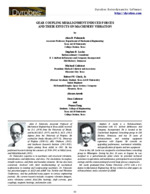Papers
“Gear Coupling Misalignment Induced Forces and Their Effects on Machinery Vibration,” |
Abstract:
Gear couplings can produce large static forces and moments that can affect the vibrations of turbomachinery, even with nearly perfect alignment. Research, testing and case histories have verified this theory and are reported. Methods are suggested to control the direction of these forces for reduced vibration and enhanced turbomachinery reliability.
Introduction:
Gear couplings are very reliable, lightweight and used exten- sively in turbomachinery. An important, but little recognized factor in using these couplings, is the presence of static forces and moments which can be quite large. Understanding these effects can help improve and/or explain the vibration behavior of turboma- chinery. These forces have the potential to significantly alter bearing loads, stiffness and damping and result in high vibration. Observations of related behavior in plant machinery led Locke to initiate this study.
The role ofthe ideal gear coupling is to transmit torque from the driven machine, while accommodating some degree ofparallel and angular misalignment between the two shafts. In reality, the torque about the axis ofthe shaft may produce bending moments about the perpendiculars to this axis, by the following three mechanisms:
- Projection of the shaft torque vector onto the perpendicular of the misaligned shaft,
- Friction forces due to torque and sliding of the misaligned teeth during rotation and,
- Offset between contact points of the teeth on opposite sides of the coupling. These bending moments are reacted by the fluid film bearings supporting the shafts. The additional preloads on the fluid film bearings have a significant influence on their stiffness and damping. Critical speeds, unbalanced response, and stability are in turn directly influenced by these bearing properties.
One very surprising characteristic of gear couplings is that the amplitude of the frictional moments and forces do not decrease with improved alignment. Nearly perfect alignment can make the direction of the forces uncertain with normal machine thermal changes. Methods are suggested to control the direction of these forces for reduced vibration and enhanced turbomachinery reliability.

